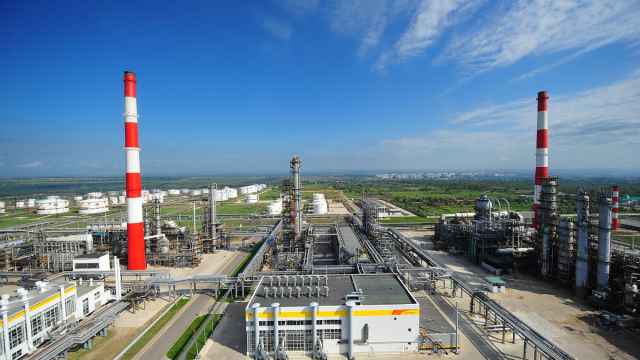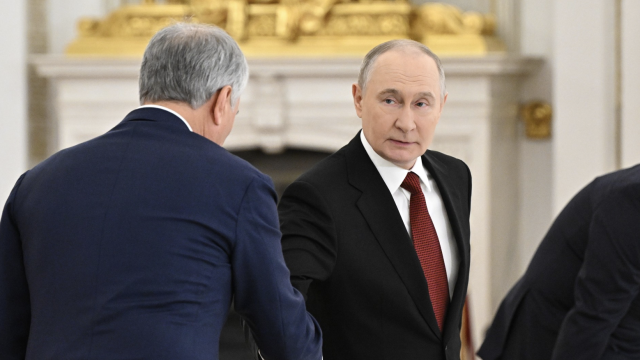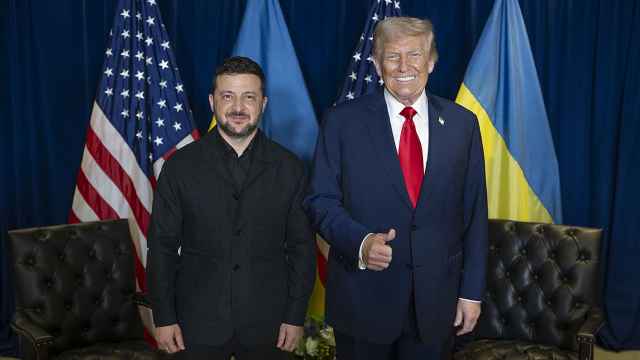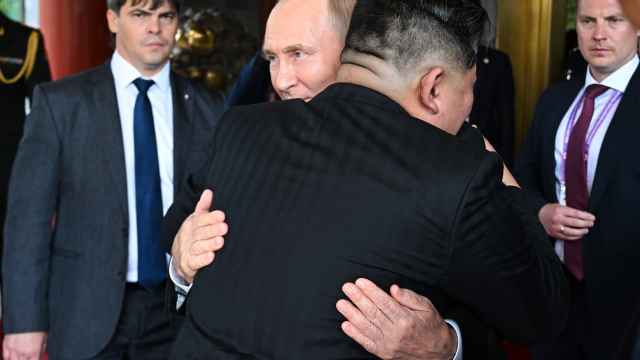Download the New Moscow map here (3.2 Mb)
A little over a year after the territory of the city of Moscow more than doubled in size, real estate prices are stabilizing, and expectations for improving infrastructure are high.
On July 1, 2012, almost 150,000 hectares of Moscow region land in the southwest and a few enclaves and exclaves to the west and northwest became part of the city. This was the result of an ambitious initiative first voiced by then-President Dmitry Medvedev in June 2011.
Aimed at resolving some of the city's problems, like huge traffic jams, the project sparked passionate debate, and many questions remain about its implementation. Yet City Hall is still committed to the idea, saying the expansion will bring economic benefits and attract investors.
Among the plans for the new territories is the creation of an international financial center, which the Kremlin hopes will boost foreign investment.
Other ambitions, such as the relocation of government and presidential administration offices to the suburbs, have not materialized. According to some media reports, the idea is too costly to implement, to say nothing of resistance by federal officials, who are determined to stay in the city center.
But the city authorities are ploughing ahead, promising a massive infrastructure upgrade and millions of square meters of additional housing in the new territories.
The announcement of the expansion plans caused a dramatic surge in demand for apartments in what was to become New Moscow. Residential real estate prices in the area skyrocketed by more than 20 percent in 2011.
The surge was fueled by expectations associated with the increased status of the territory, said Maria Litinetskaya, chief executive of Metrium Group, which include higher pensions, improved services and other social benefits. Prior to Medvedev’s announcement in 2011, the average price of newly built apartments in what was to become New Moscow was up to 70,000 rubles ($2,100) per square meter. This month, a square meter is selling for 85,000 rubles, she added.
Prices will continue to grow until the end of the year, Litinetskaya said, but the increase is likely to be in line with inflation, which is forecast at 5 percent to 6 percent.
“There is now nothing like the rapid price rises in New Moscow that we saw after the official announcement of the territories' incorporation into Moscow,” said Alexander Zubets, chief executive of Novye Vatutinki, one of the biggest development projects on the new territories, which is building 1 million square meters of residential and commercial space 14 kilometers southwest of the Moscow Ring Road.
Although demand remains high, the rush is in the past, he said in e-mailed comments.
“Buyers are no longer satisfied with just a prestigious address – they need extensive infrastructure, which New Moscow doesn't have yet,” Zubets said. The new territories' prospects depend on whether the authorities will be able to implement their announced plans to develop transportation and social infrastructure, he added.
If those plans are realized, apartment prices in some parts of New Moscow might rise on average another 15 percent to 20 percent, he added.
|
The Development of New Moscow One Year On | |||
| Subject | Plans and promises | Current status | Next steps |
| Construction | The Kremlin and City Hall officials have repeatedly pointed out that the new Moscow territories have an enormous potential for construction.
However they vowed that this part of the city won't be turned into a "concrete jungle." In April last year, then-President Dmitry Medvedev's economic aide, Arkady Dvorkovich, said there would be no high-rise construction on the new territory. City Hall sees an average number of 9 to 10 floors. City Hall revised part of the investment contracts on the territory, with the planned volume of housing construction now standing at 8 million square meters, down from the initial 15 million square meters. The new territories will also get educational institutions, medical centers and office complexes. | Construction of both housing and commercial properties on the new territories is underway. "We are in line with the schedule, there is no doubt that the planned volumes [of housing] will be completed," acting head of City Hall's department for new territories development Vladimir Zhidkin told a news conference early last month.
Among the developers of commercial properties already committed to the area is Czech development group PPF. Its localsubsidiary PPF Real Estate announced in March that it would build a $1 billion business park with offices and retail space on Kievskoye Shosse, 2 kilometers southwest of the Moscow Ring Road, to be completed by 2018. The project — one of the biggest ones planned in new Moscow — has already attracted some high-profile tenants, with national operator Rostelecom being one of the first to agree to move its headquarters. The first stage of the center is expected to be completed by the end of this year. | City Hall plans to build about 1 million square meters of housing and at least 500,000 square meters of commercial and social properties like kindergartens, schools and hospitals this year, Zhidkin told Gazeta.ru late last month. The volume of housing expected to be built annually over the next few years might reach 3 million square meters, he said.
A new master plan for city development that would take into account the territory of expanded Moscow is expected to be finished by the end of 2014. |
| Infrastructure | The infrastructure on the new territories will include 19 new roads, 38 water and 77 natural gas supply facilities, Acting First Deputy Mayor Marat Khusnullin said at a meeting on developing new Moscow territories on July 1.
City Hall, which is focused on increasing the transport access of the new districts, also plans to build metro stations there and renovate the existing roads. | City Hall's Architectural Committee is working on a plan of the new territories' transportation system, Zhidkin said. The project to build the district's transportation infrastructure will take into account plans to build the Central Ring Road, an ambitious project to develop the transportation system in the Moscow region.
It will also be linked to City Hall's plans to develop metro and railway transport in the city, Zhidkin said. | Moscow authorities plan to build three metro lines on the new territories next year.
An 8-kilometer long metro extension to be built next year will stretch from Yugo-Zapadnaya metro station in the southwest of the city and will have three stations — Troparyovo, Rumyantsevo and Salaryevo. Another one will go beyond the Novo-Peredelkino district, while the third one will stretch along Kaluzhskoye Shosse to reach Kommunarka settlement, acting Mayor Sergei Sobyanin said at the July 1 meeting. |
| Government relocation | As part of the expansion initiative Medvedev ordered that all the government agencies be removed from the city center to the territory of New Moscow. The move was aimed at relieving congestion in the city center.
Officials would be accommodated in a specially built government district comprising offices of the presidential administration, government ministries and agencies. According to the initial plan published in April last year, the project included the following stages: -July 9, 2012 — the government's made proposals to President Vladimir Putin on possible locations for the new district; -2013-2014 — design and construction works; -Late 2014 — relocation. One option proposed by the government was Kommunarka settlement, 4 kilometers southwest of the Moscow Ring Road, the Russian media reported at that time, citing government sources. In January 2012, the Office of Presidential Affairs said it would spend $136 million on townhouses for top officials near the town of Gorki-8, 21 kilometers outside of Moscow, for officials who will move there after the transfer of federal departments and agencies to the territory of New Moscow, Kommersant reported. | Rumors have swirled over the last few months that the Kremlin gave up the idea to move government facilities to the suburbs.
The move failed to get final approval from Putin, Kommersant reported last week, without citing anyone. However, Moscow's chief architect, Sergei Kuznetsov, told Kommersant in March that relocation "is, at least, being discussed." Medvedev's idea turned out to be too costly to bring to fruition, Izvestia reported in October, citing an unidentified Kremlin source. Last year, the Finance Ministry put the cost of relocation of officials to New Moscow at 500 billion rubles, Gazeta.ru reported. Implementing the project might also result in even greater traffic jams in Moscow, the source told Izvestia. By all indications, bureaucrats themselves are not excited about the idea of uprooting from their centrally-located offices. The presidential administration, which saw its staff expanded by 200 people last year, is looking for an opportunity to locate them in the city center, an official told Vedomosti last year. "Deputies won't move there," the State Duma speaker Sergei Naryshkin unequivocally told journalists earlier this year, referring to the new Moscow territories. | The future of the government district remains vague. No final decision on its location has been made yet, Zhidkin said last month.
In May, one point became clear: The Parliament will remain in the city center. A new Parliament complex will be built in downtown Moscow to unite the State Duma and Federation Council lawmakers under one roof, head of the presidential property management department Vladimir Kozhin said. The location of the complex will be announced later, he added, without specifying the exact timing. |
| Funding/Investment | Officials have made it clear that developing the new territories is a long-term plan, which means that the project will require multibillion-ruble expenditures.
"Development of the new territory is a task for decades, not for a year or two," Sobyanin said at the July 1 meeting. The teams of architects bidding for developing the new territories valued the possible costs last year at between $120 billion and $262 billion, including infrastructure. | City Hall spent approximately 21 billion rubles on developing the new territories between last July, when Moscow boundaries were extended, and the end of last year, Zhidkin said late last week.
The planned spending for this year stands at about 50 billion rubles, he added. | Khusnullin said last August that it was likely to take CityHall about a year to determine the ultimate size of investment into development of the adjoined territories.
For that, the city authorities have to analyze the design projects presented by the tender participants, he said, RIA Novosti reported. The main goal, Khusnullin said, is to choose the design that would be make the most economic sense. |
— Irina Filatova / MT
Contact the author at [email protected]
A Message from The Moscow Times:
Dear readers,
We are facing unprecedented challenges. Russia's Prosecutor General's Office has designated The Moscow Times as an "undesirable" organization, criminalizing our work and putting our staff at risk of prosecution. This follows our earlier unjust labeling as a "foreign agent."
These actions are direct attempts to silence independent journalism in Russia. The authorities claim our work "discredits the decisions of the Russian leadership." We see things differently: we strive to provide accurate, unbiased reporting on Russia.
We, the journalists of The Moscow Times, refuse to be silenced. But to continue our work, we need your help.
Your support, no matter how small, makes a world of difference. If you can, please support us monthly starting from just $2. It's quick to set up, and every contribution makes a significant impact.
By supporting The Moscow Times, you're defending open, independent journalism in the face of repression. Thank you for standing with us.
Remind me later.





